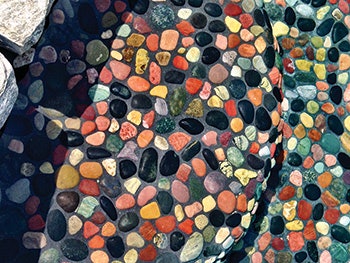
When I was a kid, my grandfather had a passion for geology and loved sharing what he knew with me. We would go to gem and mineral shows, go hiking for specimens and spend long hours in his workshop selecting, cutting and polishing stones. He was a quiet guy, didn’t say much, but when it came to appreciating geodes, quartz, marble, lava rocks and pretty much any kind of stone, he would become animated and could talk for hours.
He also loved water. In 1966, he built a cascading waterfall in the corner of my grandmother’s backyard all out of stone, along with pieces of glass and cement mortar. Even though I was very young, his love of stone, water and nature in general informed my own interests in the many decades since. (Little did I know at the time that those experiences I had with him would in a way foretell my career writing about man-made bodies of water and the materials used to create them.)
As a result, when the content I work with involves stone and other rich materials, such as tile and decorative concrete, that same passion reignites anew. After all, we all are influenced by our childhood experiences, and when it comes to designing aquatic environments, few things have as much influence on aesthetics than material choices.
That’s why this October’s edition of AQUA Architecture was such a pleasure to orchestrate and edit. In “Stonework in Progress” by builder David Owens, you’ll find a story about a young professional whose career was recently transformed by the creative use of stonework.
As Owens points out, his career had largely focused on creating vinyl and gunite pools that, while built to a quality standard, had been rather ordinary in appearance. That is, until he worked on a project for a client who happened to be a master stonemason who wanted to use the material to create a unique, natural pool environment.
I’ll leave it to Owens to tell his story, but suffice to say here it’s a prime example of how a material choice can not only drive a particular design, but an entire career.
Similarly, in “Tile Installation 101," glass tile expert Amy Denny offers a primer on installation techniques for glass tile surfaces. There again we see another powerful example of how a material, in her case, glass tile, has propelled her work into a career-defining specialty.
Like stone, glass tile has a quality that must be experienced in person to fully appreciate. As you’ll see in some of the images Amy shared with AQUA for her story, there’s a prismatic, jewel-like quality that turns these surfaces into genuine works of aquatic art.
When used in the presence of water, both stone and tile take on even more inviting qualities than dry applications. The interplay of light and water on these surfaces generates an optical spectacle that can dramatically increase the value and emotional impact of the work. Whether it’s field tile, waterlines or mosaics (or with stone, the use of boulders, pebble surfaces or architectural elements), those beautiful surfaces combined with water add up to work that is unique and often quite expensive.
To work effectively with these materials, however, you have to know what you’re doing, or you could be facing problems down the line with failed installations.
Stone must be selected based partly on its ability to withstand the rigors of water chemistry, and there are some considerable skillsets required in cutting, honing and shaping stone. Experienced masons and other stone experts will say they carefully consider each piece for its unique qualities and often spend hours picking just the right pieces for coping, pilasters, walls, vanishing edges or for more naturalistic settings in which boulders take center stage.
As for glass tile, it’s arguably the most beautiful material ever used in pools and spas, certainly the most expensive, but as Amy points out, lack of installation expertise can come back to haunt the installer and/or general contractor in a big way.
The upshot is that working with these rich materials requires both creative sensibility and technical mastery. That’s a tall order, no question, but the results of coming to speed on both the artistic and artisan sides of the equation can create surfaces and structures that endure through time and even become etched in the memories of children and adults alike who spend time in and around the water.
Comments or thoughts on this article? Please e-mail [email protected].












































